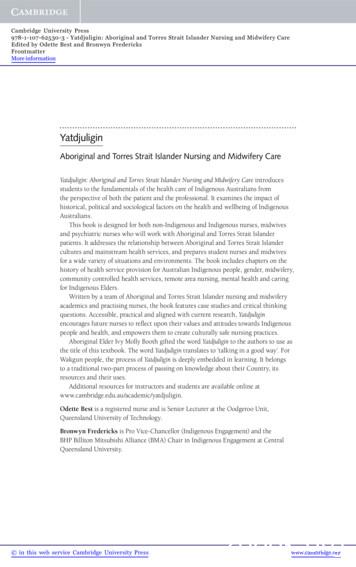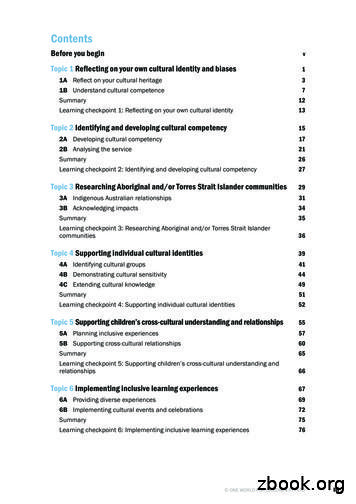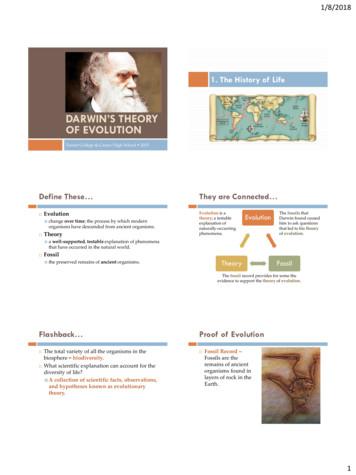THEORY In SOCIAL And CULTURAL ANTHROPOLOGY
THEORY in SOCIALand CULTURALANTHROPOLOGYAN ENCYCLOPEDIAEDITORSR. Ion McGeeRichard L. WarmsTexas State U /VG/Sl'fy‘ .SAGE referenceLos Mada: London New DelhiSlngapore Washington Dc
.SAGE reference London NewDelhiLosAngelesSingapore[WashingtonDCCopyright 2013 by SAGEPublications,Inc.All rights reserved.No part of this book may bereproducedorutilized in any form or by any means,electronicor mechanical,includingphotocopying,recording,or by any information storageand retrieval system,without permissionin writing from 455 TellerRoadThousandOaks,California91320E-mail:order sagepub.comPrintedin the United Statesof America.SAGEPublications Ltd.Library of CongressCataloging—in-PublicationData1 Oliver's Yard55CityRoadTheory in socialand cultural anthropology : an encyclopedia/ editedby R. jon McGeeand Richard L. Warms,TexasStateUniversity.London, EC1Y 1313United KingdompagescmSAGEPublicationsIndia Pvt. Ltd.B 1/I 1 Mohan ferencesand index.Mathura Road. New Delhi 110 044IndiaISBN 978-1-4129-9963-2 (hardcover)SAGEPublicationsAsia-PacificPte.Ltd.3 ChurchStreet1. Ethnology—Encyclopedias.I. McGee,R. jon, 1955—810-04 SamsungHubGN307.T54 ions Editor: Jim Brace-ThompsonDevelopmentalEditor: Sanford J. ms Manager:Leticia tems Pvt. Ltd.Proofreader:SusanSchon5 F'Certi edS ourcing: p—r—ocromolgwww.SFI-00453Indexer: Jeanne CarmelSchrire131415161710987654321
of Pennsylvania in Philadelphia, a city that hasLABOV,WILLIAMWilliamservedasa laboratoryfor muchof hisresearch.Labov (1927— ) is an AmericanlinguistDiachronic Studiesof Linguistic Behaviorand Social Patterningbest known for his central role in the foundation ofmodern sociolinguistics, and more specifically foran approach to the investigation of language in itssocial context known as var-in ows! sociolinguistics. He rose to prominence in the l960s as part ofa broad movement in the social sciences to focusattention on language as a social phenomenon inLabov broke. from linguistic tradition, which in the19605 was more and more dominated by NoamChomsky and generative grammar, by rejecting theidioiect (the variety of language unique to an individual) as the primary object of study. Generativefields like linguistics,anthropology,sociology,andGumperz,who sharea focus on the complex rela-tionship between language and society. What setsLabov apart is his end goal of developing a sociallyinformed linguistic theory and his methods, whichfocus on the quantification of variables as a meansto describing social stratification and linguisticchange. He is currently one of America‘s most dis-tinguishedlinguists,with a body of work spanning50 years.Labov grew up in Rutherford and then Fort Lee,New jersey. Educated at Harvard[BA in 1943), heworked as an industrial chemist at the Union InkCompany (1949—1960), before returning to academia at Columbia (MA in 1963, PhD in 1964).There, he workedunder the directionlinguistsconsideredlanguagea property of the indi-vidual and thus relied on individual speaker data,philosophy of language. As such, Labov’s workstands in dialogue with prominent anthropologistsfrom that period, including Dell Hymes and Johnof UrielWeinteich, a pioneer in the field of language contactand a scholar of Yiddish. Labov stayed on to teachat Columbia from 1964 to 1970. Since '1971, Labovhas been a professor of linguistics at the Universityoften in the form of intuitions or grammaticalityjudgments.In direct contrast, Labov argued thatlanguageis a community property and that individ-uals’ speechcan only be understood relative to thatof the speechcomrmmities they belong to. Speechcommunities are considered to share linguisticnorms and to be the level at which linguistic patterning can be most clearly observed. Labov also calledfor a combination of the synchronic (studies of languageat one point in time) and the diachronic (studies of change over time). This was in response totheemphasison synchronymadeby both the s[thelatter being well known in anthropology due to theinfluence of Claude Levi-Strauss).Labov‘s suggestionwas to move away from the exclusively synchronicstudy of abstract idiolects to consider the variationin communities of speakersand how these patternsof variation provide information about communitychange over time. [n this, he updated traditions indialectology, which had combined Synchrony and449
450Labov, Williamdiachronyby collectingdata in the field to answerlargelyhistorical questions.While Europeanin origin, dialectology was compatible with an earlierAmericantradition of descriptive,anthropologicallyin uencedlinguistics,deriving from Edward Sapirand Franz Boas, who were well aware of the extentof linguisticdiversity,if not necessarilyof intracom-munity variation.Synchronically, Labov set out to demonstratethat linguistic behavior varies systematicallyaccordingto the social patterningfound in speechcommunities. His first study found that local atti-tudes toward island life on Martha’s Vineyard(Massachusetts)were correlatedwith the pronun-ciation of certain vowels. He then demonstrated thesocialstratification of severalfeaturesof the NewYork City dialect.In the famousDepartmentStoreStudy,Labov visitedthree storesof differing socialstatus (Klein’s, Macy’s, and Saks), and he foundthat the salesclerkshad correspondingdifferencesin their production of the rs in the phrasefourth oor. The main part of Labov’s dissertation studywas on the Lower East Sideof Manhattan, where herecorded interviews with a random, socially stratified sample of the population. Published in 1966(revised edition, 2006) as The Social Stratificationof English in New York City, this work was morerigorousthan dialectologists’previous attemptstoobserve variation in American English. It demonstrated that severalfeatures of pronunciation variedpatterns showing individual speakers using morepostvocalic (r) in more formal styles (where moreattentionwould bepaid to speech)and middleclassspeakersleadingin their useof postvocalic(r) wereboth indicative of what Labov calls changefromabove(abovethe level of consciousawareness).Inthis case,thechangefrom aboveinvolvedthe adoption of an external prestigestandard where coda(r) was pronounced. The framework also includeschangefrom below,which for Labov is a languageand community-internalprocess,involving changesthat speakersarenot consciouslyawareof. Changefrom below was exemplifiedin New York City bythe raising of the vowel in bad toward ey (or evenee)and the vowel in bought toward 00.Much of Labov’srecentwork pursuesdiachronicquestions,including the three-volumePrinciplesofLinguistic Change (1994, 2001, 2010), which actsas a compendium of variationist sociolinguisticwork (includingLabov’sown studiesof PhiladelphiaEnglish),orientingit within the largerbodyof workseeking to understand the principles underlying lan-guagechange.Another major recent publication (with SharonAsh and Charles Boberg) is the Atlas of NorthAmerican English (2006), which presentsan acoustic analysis of the dialects of the United StatesandCanada,delineating the boundaries of the majordialect regions and characterizing broad patternsof phonological change. Based on telephone eldwork, this was the first dialect atlas to cover suchsystematicallywith the socialclassof the speakersandalsowith the styleof their speech,along a con- a large region and to be based on instrumentaltinuum from casual to formal. At the same time,measurements.LowerEastSidersof all classbackgroundsagreedinLabov aligns with the fields of dialectology andtheir negativeevaluationof the local dialect.Labov anthropology in his methodological contributions.argued that this was evidence that New YorkersHe focuses on gathering naturalistic data, tryformed a single speech community, sharing normsing to observethe type of speechpeopleusewhenfor linguistic useas well as socially stratified pat— unobserved.The most valuablespeechto elicit forterns of production.The variation present synchronically in NewYork City was further important, Labov argued, inthatit relatedto diachronicchange.For example,hefound that for the upper middle class,the youngerthe speaker,the more likely the person was to pro-nouncethe r after a vowel. Dismissingthe alterna-tive possibility of age grading—that is, that speakersuse less postvocalic (r) as they age—Labov calledthis pattern changein apparent time: The synchronicvariation between age-groups is a snapshot of achangein progressin the community.In addition,analysishe terms the vernacular, which refers to themost casualand systematicof an individual’s speechstyles.Labov pioneereda methodologyknown asthe sociolinguisticinterview, a face—to-facerecordedsessiondesignedto elicit variation across contextualstyles(from the vernacularto the very formal) inlong stretchesof naturalistic speech.The sociolinguistic interview provides the individual data that,when aggregated, is the primary evidence used insociolinguistic analysis. Today, it is often usedin combination with ethnographic observation,allowing researchersto bring both qualitative and
Labov, Williamquantitative linguistic observations to bear on theirresearchquestions.A Quantitative Approach to Data AnalysisLabov adopts a quantitative approach to data anal-ysis. His concept of the linguistic variable refersbroadly to a set of referentiallyequivalentvariants(ways of “saying the same thing”). Defining the linguistic variable allows for variants to be systematically tracked and counted acrossstretchesof speech.Labov’searliest work used tables and graphs toof useof variantssuch ascomparethe percentagesthe presenceor absenceof r in phraseslike fourthfloor, aggregatedover stylisticcontextsand/orsocialclasses.The regular patterns revealedin such displaysconstitutedthe evidencefor orderly heterogeneity and the social stratification of the speechcommunity, revealing intricate order in place ofwhat had beendismissedas chaotic free variation bystructuralistandgenerativelinguists.Later developmentsby Labov and others enableda more sophisticatedapproachto the quantitativeanalysisof language.Computer programs calledvariable rule programs (VARBRUL) were developedto estimatethe social and linguistic contextual effectson many types of linguistic alternations “coded”from naturalistic data. For example, researcherscould usea singledata setto show that a variablelike t/d deletion (e.g.,saying “wes’ coast” instead of“westcoast”) is favoredby particularsocialgroups(e.g.,by men more than by women) as well as in particular linguistic environments (e.g., before a consonant, as in lef’ hand, more than before a vowel, as inlef’ out). Over the next decades,practitioners wouldrely on this type of quantitative estimation to compare and contrast VARBRUL parameters betweendifferent varieties of a language as well as for study-ing individual varieties.Although statistical toolsother than VARBRUL are now used, sociolinguistsbuild on Labov’searlydemonstrationsthat linguisticvariationis not random but is governedby orderlyquantitative principles.Nonstandard LanguageVarieties: Beyondthe Deficit ModelLabovhasalsohada major impactthroughhis focuson thedescriptionandlegitimizationof nonstandardlanguagevarieties, most notably the variety currently known as African American English (AAE).451In Harlem in the late 19605, Labov directed a teamof field-workers who conductedethnographicallyinformed group interviews with African Americanyouth. In his 1972 book Language in the Inner City,Labov describedthe speechof his participants aslinguisticallystructured and sociolinguisticallypatterned, reiterating his stance on the orderly heterogeneity of all linguistic systems.In the case of AAE,demonstrating its systematicity was crucial at thetime, when popular theories like the deficit hypotla’esispositedthat linguistic,cultural, or evengeneticdifferencesaccountedfor the poor performanceofAfrican Americanchildren in schools.The work ofthesociologistBasilBernsteinon restrictedandelaboratedcodesalsocontributedto the popularview—one that still holds today—that AAE is a poor orincompleteversionof Englishand re ectsa broadercultural deficit for African Americans. Labov hasremainedan activistthroughout his career,workingto bring insights from sociolinguistics to a broaderaudience,both academicand popular.He testi edasan expertduring the 1979Ann Arbor trial, whichestablishedthe precedentthat the home languageof Black children should be taken into account inpublic education.More recently,he hasworked todeveloptools for educatorsthat draw on linguisticknowledge about nonstandard varieties like AAEand Latino Englishto improve the teachingof reading to minority students. Furthermore, his work hassparkeda massivesubdisciplinedevotedto thestudyof AAE, large enough to be consideredalmost a separate branch of sociolinguistics.Sociolinguisticsremains heavily in uencedbythe variationist paradigm.\Vhile someapproaches,including many qualitative subdisciplineslike discourse‘analysisand interactional n quantifiabledataand its use of fixed uisticsremainsin dialoguewiththe broaderfield. The so-calledthird waveof variationiststudies(developedby PenelopeEckert,herselfa studentof Labov’s)proposesto extendand refineearly variationism by retaining its use of empiricaland quantifiable data while calling for a renewedfocus on the individual, critiquing Labov’s assertion that individualsare worthy of studyonly in theaggregateof speechcommunities. Eckert’s focus onindividual practice, style construction, and socialmeaning also differs from Labov’s variationism indrawing on theoretical models from anthropology
452Lacan, Jacquesand social theory, including indexicality(fromCharlesSandersPeirceand more recently revivedby Michael Silverstein), enregisterment (Asif Agha),and language ideologies (Paul Kroskrity, BambiSchieffelin).Labov’sown focus on the sociallife of languageis primarily intended to inform linguistic theory.Nevertheless,his work hashad a major impact on,and retains substantial relevance for, those whowork at the intersections of language use and socialbehavior, acrossmany disciplines.Daniel Ezrajohnson and Kara BeckerSeealso Chomsky, Noam; Gumperz, john 1.; Hymes,Dell; SociolinguisticsFurther ReadingsGordon, M. J. (2006). Interview with William Labov.journal of English Linguistics,34(4), 332-35 1.(2013). Labou: A guide for the perplexed.London,.UK: Continuum.Hazen,K. (2010). Labov: Languagevariation and change.In W. Ruth, B. Johnstone, 8CP. E. Kerswill (Eds.), TheSAGE handbook of sociolinguistics(pp. 124—39).London, UK: Sage.Labov,W. (1963).The social motivation of a soundchange.Word, 19, 273-309.(1969). The logic of non-standard English. In.J. Alatis(Ed), Linguisticsand the teachingof standardEnglishto speakersof otherlanguagesand dialectsWashington,DC: GeorgetownUniversityPress.(pp. 1—44).'(1972). Languagein the inner city: Studiesin the.Black English ess.(1972).Sociolinguisticpatterns. Philadelphia:.University of Pennsylvania Press.(1994). Principlesof linguistic change:Vol. 1.Internal factors. Oxford, UK: Blackwell.(2001). Principlesof linguistic change:Vol. 2.Socialfactors. Oxford, UK: Blackwell.(2006). The socialstrati cationof English in.New York City (2nd ed.).New York, NY: CambridgeUniversityPress.(Original work published 1966)(2010). Principlesof linguistic change:Vol. 3.Cognitiveand cultural factors. Oxford, UK: Blackwell.Labov,W., Ash, 5., 8c Boberg,C. (2006). The atlas ofNorth American English: Phonetics,phonology,andsoundchange.New York, NY: Mouton de Gruyter.Weinreich,U., Labov,W, 8: Herzog, M. (1968). Empiricalfoundationsfor a theory of languagechange.InW. Lehmann 8CY. Malkiel (Eds), Directions forhistorical linguistics (pp. 95—198).Austin: UniversityofTexas Press.LACAN,JACQUESJacquesLacan (1901—1981)was a French psychia-trist andpsychoanalystwho had a deepin uenceonphilosophy, literary theory, and anthropology. Oneway to describethe work of Lacanis asan anthropology—a theory of what it meansto be human.According to Lacan,SigmundFreud’sgreatestcontribution was the invention of the unconsciousandthe emphasishe placedon sexuality,both of whichwere specificto humans.Unlike animals,governedby instincts, nature, and biology, humans weredefinedby desireand language,by their ability tosymbolize. Human subjectivity was thus always aform of intersubjectivity in which the encounterswith the social and the “Other” were key in the con-'structionof theself.Lacan’sthought presents a number of intrin-sic difficulties. On a historical level, Lacan insistedagain and again on the fact that he was simply reading Freud, that all of his concepts were anchored inFreud’stexts. Such a claim is problematic in lightof the fundamentally divergent interpretations ofFreudthroughoutthe 20th century.If Iacan’s writ—ingsfoundlittle echoin theUnitedStatesor in GreatBritain, they nonethelessradically shaped the fieldof French psychoanalysis.Whether one argued withor againsthim, Lacanbecamea necessaryreferencewithin the French context. Lacan’s work is alsoextremely complex on a theoretical level. His notoriously denseprose, his opaque references,his frequentdigressions,and his general refusal of any systematicpresentationhaveled many scholarsto misconstrueor to simply dismisshis thought. The difficulty ofLacan’s style, however; must be understood withinhis largerphilosophicalenterprise,as an attempttoperform his theory, to put it into practice. How doesone write when languageis inherently iersandsigni edare simplyconnectedby an arbitrary relation,and, most important, when the self who writes, theauthor, is neveran autonomous, centeredself?Born in 1901 in a Parisian bourgeois Catholicfamily, Lacan studied medicine before choosing
dialect regions and characterizing broad patterns of phonological change. Basedon telephone eld-work, this was the first dialect atlas to cover such a large region and to be basedon instrumental measurements. Labov aligns with the fields of dialectology and anthropology in his methodological contributions. He focuseson gathering naturalistic .
4. Cultural Diversity 5. Cultural Diversity Training 6. Cultural Diversity Training Manual 7. Diversity 8. Diversity Training 9. Diversity Training Manual 10. Cultural Sensitivity 11. Cultural Sensitivity Training 12. Cultural Sensitivity Training Manual 13. Cultural Efficacy 14. Cultural Efficacy Training 15. Cultural Efficacy Training Manual 16.
theory and models / theory and practice / viewing the theory / types of theory / value of theory for social work / theoretical perspective of social work The ecological systems theory perspective 91 human ecology / systems theory
3 The cultural safety journey: An Australian nursing context 51 Odette Best Introduction 52 Developing the theory of cultural safety 52 The Australian context: Developing cultural awareness 54 Moving beyond cultural awareness to cultural sensitivity 62 The continuous journey towards cultural safety 63
4 Social and cultural anthropology guide Social and cultural anthropology is the comparative study of culture and human societies. Anthropologists seek an understanding of humankind in all its diversity. This understanding is reached through the study of societies and cultures and the exploration of the general principles of social and cultural .
Topic 1 Reflecting on your own cultural identity and biases . 1 1A Reflect on your cultural heritage 3. 1B Understand cultural competence 7 Summary 12. Learning checkpoint 1: Reflecting on your own cultural identity 13. Topic 2 Identifying and developing cultural competency . 15 2A Devel
Cultural competence needs to be seen as a continuum from basic cultural awareness to cultural competence; effort must be made to move beyond knowledge towards cultural sensitivity and competence (Adams, 1995). Developing sensitivity and understanding of another ethnic group Cultural awareness must be
Humanist Learning Theory 2 Introduction In this paper, I will present the Humanist Learning Theory. I’ll discuss the key principles of this theory, what attracted me to this theory, the roles of the learners and the instructor, and I’ll finish with three examples of how this learning theory could be applied in the learning environment.File Size: 611KBPage Count: 9Explore furtherApplication of Humanism Theory in the Teaching Approachcscanada.net/index.php/hess/article/view (PDF) The Humanistic Perspective in Psychologywww.researchgate.netWhat is the Humanistic Theory in Education? (2021)helpfulprofessor.comRecommended to you b
Evolution is a THEORY A theory is a well-supported, testable explanation of phenomena that have occurred in the natural world, like the theory of gravitational attraction, cell theory, or atomic theory. Keys to Darwin’s Theory Genetic variation is found naturally in all populations. Keys to Darwin’s Theory























